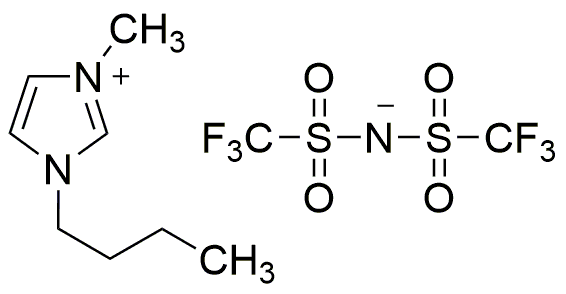1-Butyl-3-methylimidazolium bis(trifluoromethanesulfonyl)imide is widely utilized in research focused on:
- Green Chemistry: This compound serves as an effective ionic liquid, enabling environmentally friendly chemical reactions by reducing the need for volatile organic solvents, thus minimizing hazardous waste.
- Electrochemistry: It is used in the development of advanced electrolytes for batteries and supercapacitors, enhancing energy storage capabilities and improving overall efficiency compared to traditional liquid electrolytes.
- Separation Processes: This chemical is applied in liquid-liquid extraction processes, particularly in the separation of metals from solutions, offering higher selectivity and recovery rates than conventional methods.
- Biomass Processing: It plays a role in the conversion of biomass into biofuels, facilitating the breakdown of complex organic materials into simpler, more usable forms, which is crucial for sustainable energy solutions.
- Pharmaceutical Applications: The compound is explored for its potential in drug delivery systems, where its unique properties can enhance solubility and bioavailability of pharmaceutical compounds, leading to more effective treatments.
General Information
Properties
Safety and Regulations
Applications
1-Butyl-3-methylimidazolium bis(trifluoromethanesulfonyl)imide is widely utilized in research focused on:
- Green Chemistry: This compound serves as an effective ionic liquid, enabling environmentally friendly chemical reactions by reducing the need for volatile organic solvents, thus minimizing hazardous waste.
- Electrochemistry: It is used in the development of advanced electrolytes for batteries and supercapacitors, enhancing energy storage capabilities and improving overall efficiency compared to traditional liquid electrolytes.
- Separation Processes: This chemical is applied in liquid-liquid extraction processes, particularly in the separation of metals from solutions, offering higher selectivity and recovery rates than conventional methods.
- Biomass Processing: It plays a role in the conversion of biomass into biofuels, facilitating the breakdown of complex organic materials into simpler, more usable forms, which is crucial for sustainable energy solutions.
- Pharmaceutical Applications: The compound is explored for its potential in drug delivery systems, where its unique properties can enhance solubility and bioavailability of pharmaceutical compounds, leading to more effective treatments.
Documents
Safety Data Sheets (SDS)
The SDS provides comprehensive safety information on handling, storage, and disposal of the product.
Product Specification (PS)
The PS provides a comprehensive breakdown of the product’s properties, including chemical composition, physical state, purity, and storage requirements. It also details acceptable quality ranges and the product's intended applications.
Certificates of Analysis (COA)
Search for Certificates of Analysis (COA) by entering the products Lot Number. Lot and Batch Numbers can be found on a product’s label following the words ‘Lot’ or ‘Batch’.
*Catalog Number
*Lot Number
Certificates Of Origin (COO)
This COO confirms the country where the product was manufactured, and also details the materials and components used in it and whether it is derived from natural, synthetic, or other specific sources. This certificate may be required for customs, trade, and regulatory compliance.
*Catalog Number
*Lot Number
Safety Data Sheets (SDS)
The SDS provides comprehensive safety information on handling, storage, and disposal of the product.
DownloadProduct Specification (PS)
The PS provides a comprehensive breakdown of the product’s properties, including chemical composition, physical state, purity, and storage requirements. It also details acceptable quality ranges and the product's intended applications.
DownloadCertificates of Analysis (COA)
Search for Certificates of Analysis (COA) by entering the products Lot Number. Lot and Batch Numbers can be found on a product’s label following the words ‘Lot’ or ‘Batch’.
*Catalog Number
*Lot Number
Certificates Of Origin (COO)
This COO confirms the country where the product was manufactured, and also details the materials and components used in it and whether it is derived from natural, synthetic, or other specific sources. This certificate may be required for customs, trade, and regulatory compliance.


